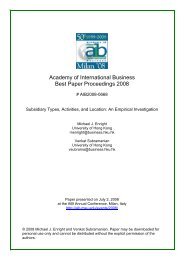AIB 2012 Conference Proceedings - Academy of International ...
AIB 2012 Conference Proceedings - Academy of International ...
AIB 2012 Conference Proceedings - Academy of International ...
You also want an ePaper? Increase the reach of your titles
YUMPU automatically turns print PDFs into web optimized ePapers that Google loves.
MONDAY<br />
coordination <strong>of</strong> the R&D organization. We discuss implications for theory and practice and outline some<br />
empirical methodologies to test these propositions. (For more information, please contact: Charles Dhanaraj,<br />
Indiana University, USA: dhanaraj@iupui.edu)<br />
Session: 2.1.5 - Competitive<br />
Track: 3 - IB Theory, FDI, and Entry Mode<br />
New Perspectives on <strong>International</strong>ization<br />
Presented On: July 2, <strong>2012</strong> - 09:00-10:15<br />
Chair: Klaus Meyer, China Europe <strong>International</strong> Business School<br />
Dispersion <strong>of</strong> <strong>International</strong>ization and Firm Performance: A Contextualist Three-Stage Model<br />
Pham Hoanh Son Nguyen, ESC Clermont Graduate School <strong>of</strong> Management<br />
Tugrul Atamer, EMLYON Business School<br />
Alain Charles Martinet, University Jean Moulin Lyon 3<br />
The academic interest in the relationship between <strong>International</strong>ization and Performance (RIP) has grown<br />
steadily during the last four decades. Based on different theories and methodological approaches, researchers<br />
propose and confirm empirically RIP <strong>of</strong> various natures. Consequently, they have developed various alternative<br />
approaches to model RIP such as negative, positive and linear, U standard and U inverted. In this context, the<br />
three-stage model <strong>of</strong> Lu and Beamish (2004) and Contractor, Kundu and Hsu (2003), emerges as an integrator<br />
model capable <strong>of</strong> reconciling other efforts to model RIP. However, this integrator model has, in our point <strong>of</strong><br />
view, two limitations: (1) the absence <strong>of</strong> the context <strong>of</strong> internationalization, in particular, the cultural and<br />
institutional environment in the theoretical analysis and development; (2) the inability to show the nature <strong>of</strong> the<br />
impact <strong>of</strong> dispersion <strong>of</strong> internationalization on performance. To overcome these limitations, we propose, in this<br />
work, to use the dispersion <strong>of</strong> internationalization as a vector by which the context <strong>of</strong> internationalization is<br />
incorporated into the analysis on the impact <strong>of</strong> degree <strong>of</strong> internationalization on performance. This research,<br />
based on a sample <strong>of</strong> 69 large international French enterprises over 7 years, 2001-2007, contributes to RIP<br />
research by providing the following new theoretical, empirical and methodological elements: (i) the three-stage<br />
model applies not only to the relationships between the breadth <strong>of</strong> internationalization and performance, or the<br />
depth <strong>of</strong> internationalization and performance, but also to the dispersion <strong>of</strong> internationalization and<br />
performance; (ii) it is not only the degree <strong>of</strong> internationalization itself that explains the firm's performance but<br />
also the context <strong>of</strong> internationalization. (For more information, please contact: Pham Hoanh Son Nguyen, ESC<br />
Clermont Graduate School <strong>of</strong> Management, France: pham.nguyen@esc-clermont.fr)<br />
Modeling the Speed <strong>of</strong> <strong>International</strong>ization: Examining the Different Modes <strong>of</strong> <strong>International</strong>ization According to<br />
their Timing and Speed<br />
Masahiro Kotosaka, University <strong>of</strong> Oxford<br />
This research adopted an exploratory, case-based theorising approach and empirically examined the model <strong>of</strong><br />
forces influencing the speed <strong>of</strong> internationalization developed by Oviatt and McDougall (2005). This study<br />
proposed a 4-by-4 matrix consisting <strong>of</strong> the time axis and the speed axis in order to compare the different modes<br />
<strong>of</strong> internationalization. By treating timing and speed differently, this study discussed potential refinements to the<br />
Oviatt and McDougall model, especially if it is to accommodate Born-again Global firms and <strong>International</strong> Small<br />
Firms. This study contributes to the understanding <strong>of</strong> the two distinguishing factors <strong>of</strong> internationalization: the<br />
timing and the speed. This paper argues the firm's competitive advantage, which is a result <strong>of</strong> access to the<br />
knowledge, networks, and resource, works as the moderating force determining the speed <strong>of</strong> expansion,<br />
together with the opportunity, enabling, motivating, and mitigating factors explained by Oviatt and McDougall's<br />
<strong>AIB</strong> <strong>2012</strong> <strong>Conference</strong> <strong>Proceedings</strong><br />
Page 105

















